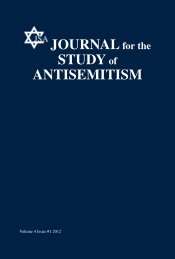JOURNALfor the STUDYof ANTISEMITISM
JOURNALfor the STUDYof ANTISEMITISM
JOURNALfor the STUDYof ANTISEMITISM
Create successful ePaper yourself
Turn your PDF publications into a flip-book with our unique Google optimized e-Paper software.
2011] <strong>ANTISEMITISM</strong> IN WAGNERIAN OPERA 249<br />
characteristic also seen in <strong>the</strong> stumbling of Beckmesser as contrasted with<br />
<strong>the</strong> graceful dancing of <strong>the</strong> townspeople in Meistersinger.<br />
In Sander Gilman’s The Jew’s Body (1991), fur<strong>the</strong>r significance is<br />
given to <strong>the</strong> Jew’s feet. They became a source of disease, and <strong>the</strong> pace at<br />
which Jews walked was perceived as a sign of <strong>the</strong>ir affliction. The seventeenth-century<br />
Orientalist John Schudt commented that <strong>the</strong> crooked feet of<br />
<strong>the</strong> Jews made <strong>the</strong>m physically inferior and, ultimately, <strong>the</strong> general belief<br />
about Jews’ feet influenced liberal efforts to include <strong>the</strong>m in <strong>the</strong> modern<br />
state. This is particularly true with military service, where it was believed<br />
that Jews would be worthless as soldiers. In Austria, for example, weak feet<br />
were said to be <strong>the</strong> main reason Jews inducted into <strong>the</strong> military were subsequently<br />
detached.<br />
Ano<strong>the</strong>r example of a characteristic with hidden antisemitic meaning is<br />
that of vocal patterns. Wagner’s formulation of a large-scale male and<br />
female voice, for example, <strong>the</strong> “heroic tenor,” is used for <strong>the</strong> Volk, whereas<br />
<strong>the</strong> outsiders sing in distinguishing non-Volkish ways. The gnomes in The<br />
Ring have high and piercing voices, <strong>the</strong> same coded message for <strong>the</strong> confusion<br />
between castration and circumcision found in Meistersinger, as well as<br />
a related claim connecting circumcision with effeminacy in <strong>the</strong> Jewish<br />
male. Thus, <strong>the</strong> Volk sing with heroic qualities while <strong>the</strong> outsider screams<br />
in a high-pitched, effeminate voice.<br />
Going beyond <strong>the</strong> visual and acoustic, Wagner employs <strong>the</strong> allegory of<br />
smell to evoke images of character. Sulphurous fumes and <strong>the</strong> noxious<br />
stenches that emanate from <strong>the</strong> outsider often accompany <strong>the</strong>m. The central<br />
<strong>the</strong>me of this coded idea is especially despicable because it is derived from<br />
<strong>the</strong> belief of <strong>the</strong> “Jewish stench,” or “foetor Judaicus.” 8<br />
The assertion that <strong>the</strong> Jew has a distinctive and unpleasant odor is a<br />
particularly grave accusation, first because of <strong>the</strong> origin alleged to be <strong>the</strong><br />
stench’s cause, and second because of <strong>the</strong> several ways Jews were said to<br />
act in order to eliminate it. Common belief during <strong>the</strong> Middle Ages associated<br />
good spirits with emitting a pleasant fragrance while evil spirits, particularly<br />
Satan and his minions, gave forth an obnoxious stench. For example,<br />
when <strong>the</strong> coffin of St. Stephen, <strong>the</strong> protomartyr, was opened, his body was<br />
said to have filled <strong>the</strong> air with a sweet fragrance that insinuated <strong>the</strong> odor of<br />
sanctity. 9 In <strong>the</strong> case of <strong>the</strong> Jews, <strong>the</strong> stink was said to be a punishment for<br />
8. For a survey of this degrading medieval superstition, see Jay Geller,<br />
“(G)nos(e)ology: The Cultural Construction of <strong>the</strong> O<strong>the</strong>r,” chap. 10 in People of<br />
<strong>the</strong> Body, ed. Howard Eilberg Schwartz (Albany, NY: State University of New<br />
York, 1992), 243-282.<br />
9. See Stephen <strong>the</strong> Deacon, Protomartyr, in http://www.saintpatrickdc.org/ss/<br />
1226.shtml.














